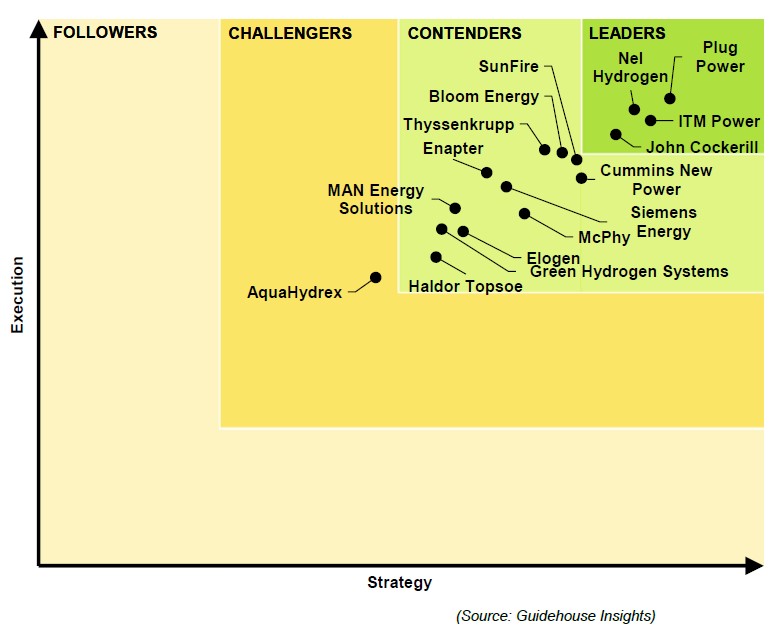Electrolyzer 101: Growing Green Hydrogen
Plug’s hydrogen electrolyzer products allow customers to produce green hydrogen onsite, reducing the amount of carbon emissions we emit into the world.
The calls to reduce our carbon footprint and transition to renewable energy sources have never been louder. The UN released a climate change report in March 2022 with a dire warning to decision makers that the time to act is now. And, policy makers in Europe are scrambling to find other energy sources with the invasion of Ukraine. These troubling news stories are concerning even for the extreme optimists. But the good news is that there is hope with green hydrogen.
Why? The answer is simple. Green hydrogen is produced from renewable sources like wind, water or solar. Other forms of hydrogen are produced from non-sustainable sources that release carbon emissions. Whereas green hydrogen only releases oxygen.
Plug believes that green hydrogen is capable of powering at least 20% of our planet. With that belief in mind, we are working rapidly to provide green hydrogen products to as many customers as possible. Plug has several production plants in the works with two scheduled to come online by the end of 2022. By 2025, we expect to produce 500 tons of liquid green hydrogen. The number is expected to double by 2028.
Plug’s hydrogen electrolyzer products are the key to bringing that plan to reality. So, what’s an electrolyzer and how does it work?
What’s an Electrolyzer?
An electrolyzer is a product that uses electricity to split water into hydrogen and oxygen — a process called electrolysis. If you are familiar with how fuel cells work, electrolyzers are essentially the reverse process. There are different types of hydrogen electrolyzers that can function in different ways, depending on the type of membrane used.
At the most basic level, water is provided to the electrolyzer stack, which looks like a multi-decker sandwich. The layers use a special membrane painted with a catalyst to separate the water into hydrogen and oxygen, using electricity to power the reaction. We then capture and store the hydrogen for a variety of end uses.
Behind the electrolyzer is the power the makes it work. This power can be provided by whatever means makes the most sense for each customer. Sometimes that is grid power, provided by the local utility. Other times, it’s renewable energy, like wind, solar or hydroelectric power.
With one of the most experienced teams in Proton Exchange Membrane (PEM) electrolysis technology, Plug understands the process intimately, having innovated the technology for decades. We were even recently named the number one hydrogen electrolyzer company by Guidehouse Insights.

What Can Electrolyzed Hydrogen be Used For?
Plug offers plug-and-play hydrogen electrolyzer products, as well as custom-engineered, built-to-order integrated solutions to meet any type of demand. Our product offering covers the entire spectrum of the ecosystem covering production, storage and handling, dispensing, delivery and more.
Here’s a breakdown of the industries we cover:
- Power to X: Refineries and chemical, steel, and fertilizer producers can reduce their carbon footprint with green hydrogen.
- Power to Mobility: Hydrogen fueling stations for fuel cell-powered buses, cars, trains, forklifts, trucks and other vehicles.
- Power to Power: Not one renewable electron should go to waste. Green hydrogen enables renewable energy to be accessed by anyone at any time.
- Power to Gas: Green hydrogen can be burned (usually blended with natural gas) to heat homes and businesses. Blending hydrogen into the natural gas pipelines is another way to reduce carbon emissions.
Where are Plug’s Products Going?
In addition to the growing number of corporate customers using Plug hydrogen, the federal administration is also relying on Plug, the leader of the green hydrogen movement, and others to help the country move toward clean energy solutions within the decade. The U.S. Department of Energy’s Energy Earthshots Initiative has been implemented to reduce the cost of hydrogen by 80%. To achieve this goal, the DOE is funding multiple hydrogen hubs around the U.S., with the goal of making hydrogen ubiquitous. When this happens, the country can expect a five-fold increase in clean hydrogen use and a nearly 16% carbon dioxide emission reduction by 2050. Experts also estimate the investment in clean hydrogen will result in $140 billion in revenue and 700,000 jobs by 2030 in the U.S.
The company behind the Green Hydrogen Ecosystem, Plug is making hydrogen adoption simple for companies ready to improve both efficiency and sustainability of their operations. Ready to explore Plug’s world-class hydrogen electrolyzer products? Contact us.